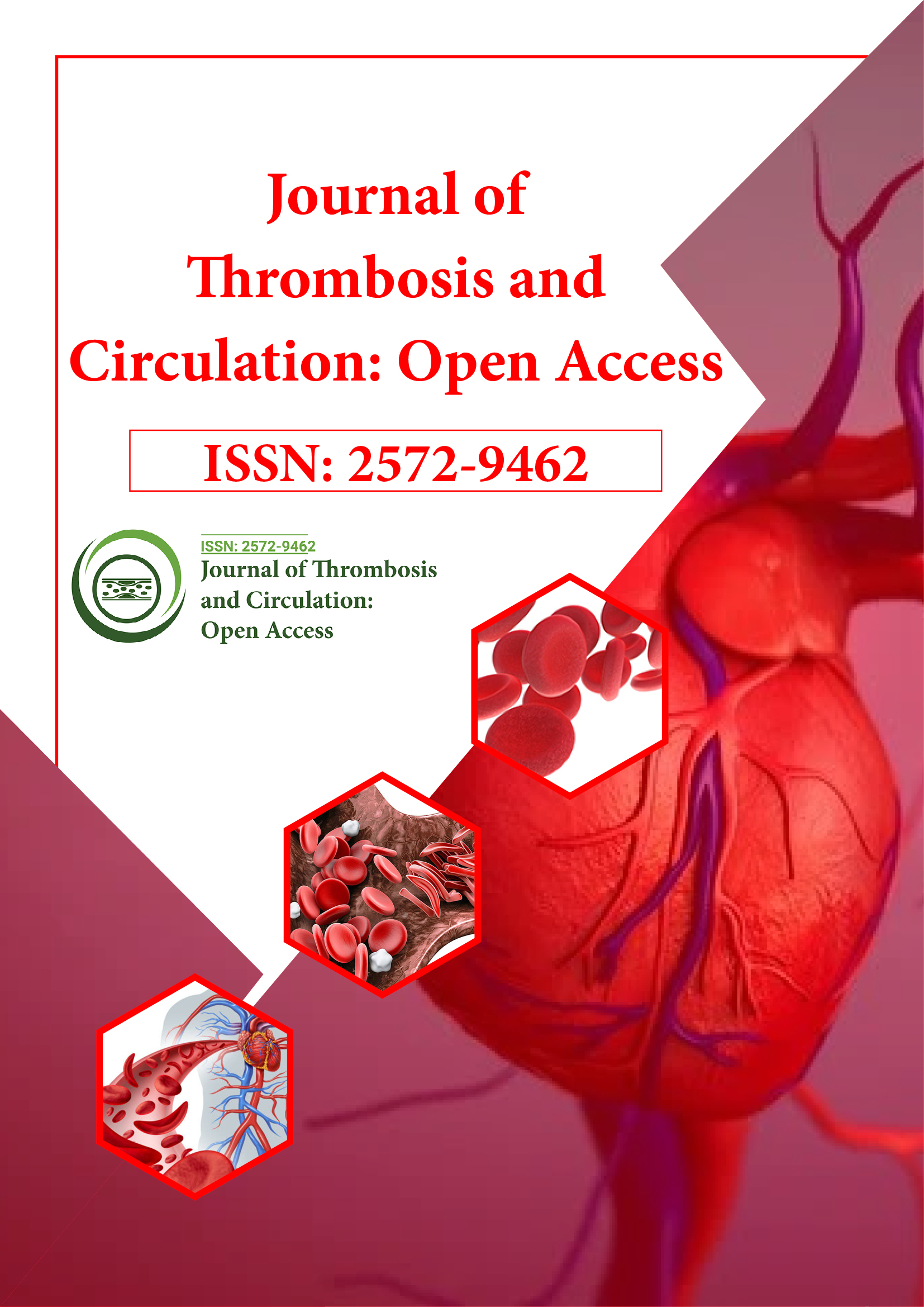Indexed In
- RefSeek
- Hamdard University
- EBSCO A-Z
- Publons
- Google Scholar
Useful Links
Share This Page
Journal Flyer

Open Access Journals
- Agri and Aquaculture
- Biochemistry
- Bioinformatics & Systems Biology
- Business & Management
- Chemistry
- Clinical Sciences
- Engineering
- Food & Nutrition
- General Science
- Genetics & Molecular Biology
- Immunology & Microbiology
- Medical Sciences
- Neuroscience & Psychology
- Nursing & Health Care
- Pharmaceutical Sciences
Short Communication - (2021) Volume 7, Issue 6
Predominant Vena Cava Disorder after Pacemaker Implantation Treated with Direct Oral Anticoagulation
Kranthi Kumar*Received: 01-Nov-2021 Published: 22-Nov-2021
Introduction
Prevalent Vena Cava (SVC) disorder, is a very uncommon however genuine complexity after pacemaker lead implantation; most patients are asymptomatic because of the improvement of sufficient venous security dissemination. The Superior Vena Cava (SVC) represents the main drainage vessel for the venous blood of the head, neck, upper extremities, and upper chest.
Case Presentation
The Superior Vena Cava (SVC) addresses the primary seepage vessel for the venous blood of the head, neck, furthest points, and upper chest. SVC condition is an exceptionally uncommon however crippling inconvenience after pacemaker lead implantation. Indications rely upon how rapidly the hindrance sets up [1]. They incorporate cerebral pain, upper appendage edema, jugular vein enlargement, cyanosis, and facial expanding. The clinical history included pacemaker implantation 2years before for wiped out sinus condition; actual assessment uncovered cyanosis, edema, and conspicuous engorged vasculature on the face, neck, reciprocal upper appendages and foremost chest divider Complete blood count, coagulation, renal and hepatic capacity were inside typical cutoff points. Inflatable angioplasty was considered however the patient declined. Because of the significant stretch of beginning of indications, treatment with fibrinolytics was not thought of as proper. Following seven days of full portion subcutaneous enoxaparin, anticoagulation with Edoxaban 60mg whenever day by day was begun and continuously a total goal of the indications was acquired [2].
Discussion and Conclusion
Prevalent Vena Cava (SVC) disorder is an extremely uncommon however crippling entanglement after pacemaker lead implantation. Side effects rely upon how rapidly the hindrance builds up; be that as it may, the insurrection of apoplexy brought about by pacemaker drives is by all accounts random to the time slipped by from the technique. Most patients are frequently less suggestive because of the improvement of insurance flow. A few makes lead this condition. The most widely recognized is harm (85%): cellular breakdown in the lungs, lymphomas; metastasis to the mediastinum from bosom malignant growth or gastrointestinal cancers, essential mediastinal growths [3]. The instruments most involved are outward pressure and neoplastic penetration of SVC. Less usually, non-oncologic causes might happen: contaminations, unconstrained apoplexy, and iatrogenic causes. Among the last option, radiotherapy on the mediastinum and apoplexy or contaminations of intravascular gadgets (focal vein catheters, heart defibrillators, and pacemaker wires) is turning out to be progressively normal. Strategies performed on venous vasculature, causing a potential intimal physical issue or vein stenosis, incited by trans venous drives, appear to be the most sensible clarification for the noticed inconvenience. The therapy of SVC condition includes the utilization of clinical, interventional, or careful treatment [4]. Clinical administration incorporates anticoagulants or thrombolytic; interventional methods usually performed incorporate inflatable angioplasty and stenting. The term of indications before the beginning of thrombolytic treatment, can frequently direct the most fitting methodology. The achievement pace of thrombolytic treatment is more noteworthy in the event that treatment is started not exactly or equivalent to 5days after the manifestations began. Endovascular fix is less intrusive yet similarly successful contrasted with the careful methodology. The open fix treatment is for the most part utilized in SVC condition due to mediastina fibrosis. At the point when the reason is pacemaker implantation two medicines are conceivable. The first is the lead expulsion, stent implantation, and reimplantation of new leads, yet the drawn out adequacy of this methodology is obscure. Besides, because of the long steadiness of side effects, we theorized that the apoplexy was not intense, and estimated that anticoagulation ought to reestablish a positive harmony between apoplexy perseverance and physiologic fibrinolysis, prompting clots goal. The anticoagulation treatment of furthest point profound vein apoplexy (UE-DVT) has not been normalized at this point; nonetheless, the current practice is to begin warfarin following 5 to 7 days of low-atomic weight heparin [5].
REFERENCES
- Teo N, Sabharwal T, Rowland E, Curry P, Adam A. Treatment of superior vena cava obstruction secondary to pacemaker wires with balloon venoplasty and insertion of metallic stents. Eur Heart J. 2002; 23:1465–1470.
- Sfyroeras GS, Antonopoulos CN, Mantas G, Moulakakis KG, Kakisis JD, Brountzos E, et al. A review of open and endovascular treatment of superior vena cava syndrome of benign Aetiology. Eur J Vasc Endovasc Surg. 2017; 53:238–254.
- Picascia O, Fiorini V, Vitale G, Quassone P, Scognamiglio M, Ferrandino G, et al. Iatrogenic superior vena cava syndrome with concomitant deep vein thrombosis of azygos and hemiazygos veins. Radiol Case Rep. 2021; 16:1895–1898.
- Mazzetti H, Dussaut A, Tentori C, Dussaut E, Lazzari JO. Superior vena cava occlusion and/or syndrome related to pacemaker leads. Am Heart J. 1993; 125:831–837.
- Montiel FS, Ghazvinian R, Gottsäter A, Elf J. Treatment with direct oral anticoagulants in patients with upper extremity deep vein thrombosis. Thromb J. 2017;15:26.
Citation: Kumar K (2021) Predominant Vena Cava Disorder after Pacemaker Implantation Treated with Direct Oral Anticoagulation. J Thrombo Cir 7: 171
Copyright: © 2021 Kumar K. This is an open-access article distributed under the terms of the Creative Commons Attribution License, which permits unrestricted use, distribution, and reproduction in any medium, provided the original author and source are credited.
